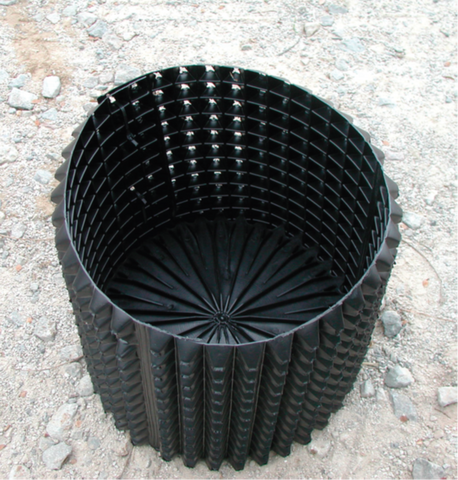RootBuilder®: A Unique, Efficient Container
Carl Whitcomb PhD, Lacebark Research Farm, Stillwater, OK
Conventional round plastic containers are notorious for deformed root systems. The problem occurs with all plants of all species. However, the severity of the problem is greatest with woody trees and shrubs which need good anchorage to support the tops. Cutting or disrupting congested and circled roots at planting is often suggested, but numerous research studies have shown no benefits. Simply cutting holes in container sidewalls does almost nothing to help. In 1968, I created holes in sidewalls of one gallon containers only to find no benefits. In 1986, I created a series of larger triangular openings in smooth walled containers in an attempt to stop root circling. However, as roots grew out and were deflected along the curved sidewall, they grew past the openings and continued to circle. In addition, growth media exposed through the many and sizeable openings increased water loss, salt accumulation and weed problems.
With the entire sidewall of outward projecting, downward sloping, and pyramidal cones, RootBuilder®, Patent #7,481,025, solves the circling root problem in a unique way. Each cone is one inch square at the base and tapers to a small opening at the tip. All of the openings amount to less than 5% of the sidewall surface area. This keeps water loss due to evaporation to a minimum. As roots grow out and contact the container sidewall, each root tip is guided into one of the cones and is air-root pruned at the tip.
Each outward projecting cone slopes downward slightly on the bottom, but slopes much more on the top. Due to the effect of gravity, most roots grow along the bottom of the cone as they extend toward the opening. This feature helps protect active root tips from heat stress and decreases chance that a weed seed will blow against the sidewall and germinate. With the steep upper slope, most weed seeds are washed off with the next rain or irrigation. In addition, because of the shaping and positioning of the outwardly projecting cones, each cone partially or completely shades the one below. This shading of one cone by the other keeps the sidewall much cooler, and allows roots to survive on the sunny side of the container even thought the container is black.

Figure 1. Used as a quart size container, an extremely fibrous root system is created on a small plant. This size is particularly suited for grafting stock because stout stems are created. The container may be used over and over.
When a root tip is pruned by air/dehydration, additional secondary roots are promptly produced back along the axis of the root about four inches. This unique container can be made in sizes ranging from one quart, three gallon or five gallon with a bottom (Figures 1 and 2) to 200 gallons or more (Figure 3).

Figure 2. The one quart, three and five gallon sizes come as a kit that includes a bottom. Note the unique shaping of the network of sidewall cones and the bottom with ribs to direct roots to the side openings for further air-pruning.

Figure 3. The only limitation to the size of a RootBuilder® container is the imagination and available equipment. By using three straps to form an effective sling, this six inch stem diameter oak tree was easily lifted for positioning on a load. At the planting site, simply cut the four fasteners at the vertical connection and the container is removed with zero effort and is ready to be reused.
The one quart, three and five gallon sizes are sold as kits that include a bottom and sidewall fasteners. The bottom is flat and container sidewalls are vertical, making plants much less prone to blow over. To make a larger container, cut the desired length and fasten the two ends. Place the container ring on the optional RootTrapper® fabric disk or on a sheet of polyethylene. Install the plant as the container is filled with a good container growth medium. To remove a plant from this container, simply cut the fasteners and the root system is free. And these containers can be used over and over. Any plant develops an extremely fibrous root system, no root circling and root tips poised to grow both horizontally as well as downward at time of planting. Because plants grown in these containers establish promptly in the landscape, little plant stress occurs and losses are unlikely (Figure 4).

Figure 4. Plants grown in the unique RootBuilder® container develop an extremely fibrous root system. Roots are poised to grow in all directions radially following planting, as well as downward. And, no circling, kinking or root deformity problems.
I began studying and modifying plastic containers in 1968. Since that time much as been learned and I have created and tested an assortment of new container designs. The consistent objective has been to stop roots from circling and stimulate root branching. For the complete story on growing plants in containers, read Plant Production in Containers II, available at www.lacebarkinc.com.
Oscar Vaz
Your pots really work. I continue to be amazed at how different the root ball look when removed from one of your pots. I was skeptical at first. I continue to place small order to increase my inventory of your pots.